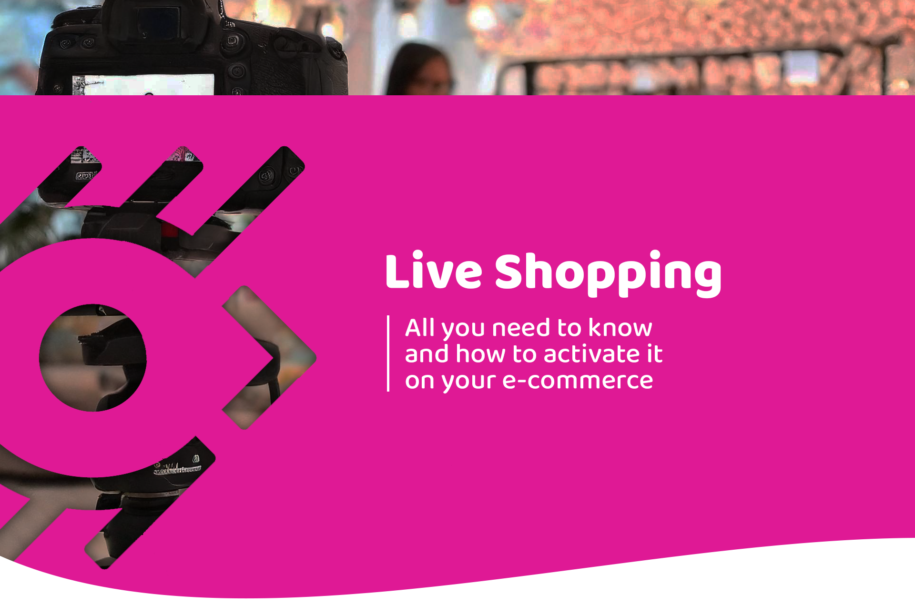In this article, we’ll show you everything you need to know about this powerful Video Commerce tool. We’ll analyze the main trends and give you advice on how to implement it successfully on your site.
Index
What is Live Shopping?
As the name suggests, Live Shopping is a method of online selling where products are presented and promoted through live video broadcasts.It is a form of eCommerce that allows consumers to shop by participating in interactive live streaming sessions. Users can follow live broadcasts from their favorite brands, discover the showcased products, and purchase them during the live session itself.
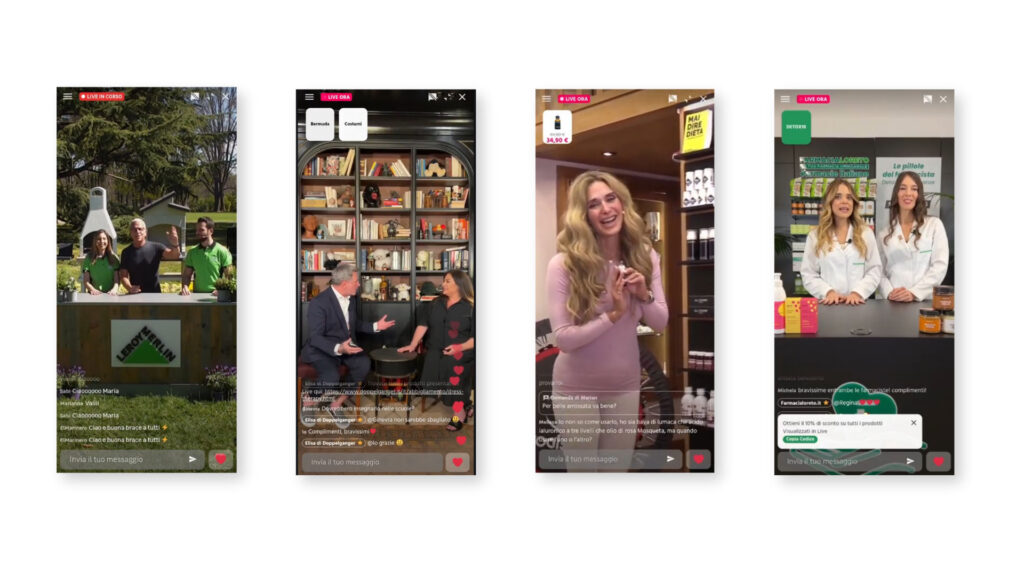
Teleshopping 2.0? Differences between Live Shopping and Teleshopping
Live Commerce could be seen as an advanced version of traditional teleshopping. While teleshopping may seem like a relic of the past, Live Shopping is proving to be a winning strategy for capturing the attention of an increasingly digital audience.
There are certainly similarities between these two selling methods: both, for example, rely on live broadcasts with products presented for purchase in real-time from home. However, there are also significant differences, and it would be wrong to think of Live Commerce as a form of teleshopping 2.0. So what are these differences?
Firstly, interactivity. Live events are highly interactive, thanks to features like chat, reactions, and polls. Connected to this aspect is bidirectionality. While teleshopping was essentially a one-way form of communication from the seller to the viewer, live broadcasts allow users to actively participate and engage in a conversation – not just from host to user but also from user to host/company.
The approach to presenting products and, more broadly, communication also changes: while teleshopping leans towards persuasion and promotion, live broadcasts emphasize authenticity and the sharing of valuable content.
The Origins of Live Shopping: Live Streaming in China
The phenomenon of Live Shopping originated in China. It was in 2016 when Taobao, the marketplace of the Chinese eCommerce giant Alibaba, launched Taobao Live. Since then, the trend of brands selling via live streaming on platforms like Taobao or Douyin (the Chinese version of TikTok) has rapidly spread, especially during the pandemic.
McKinsey & Company tells us that in just 3 years, from 2017 to 2020, the Chinese Live Commerce market recorded a compound annual growth rate of 280%. In 2022, this market reached a value of $500 billion (source: eMarketer), accounting for 25% of total online sales (source: Statista).
In China, the phenomenon of Live Shopping is mainly associated with two types of figures: Key Opinion Leaders (KOLs) and Key Opinion Consumers (KOCs). These are influencer figures capable of attracting a large number of users to Live Commerce platforms and selling large quantities of products during long-lasting broadcasts – sometimes exceeding 7 hours. Top influencers sell items worth millions of yuan during a single live session. Some of the most famous KOLs in recent years include Austin Li, “The Lipstick King,” and Viya Huang, “The Live-streaming Queen” (although she experienced difficulties in 2021 following a fine for tax evasion).
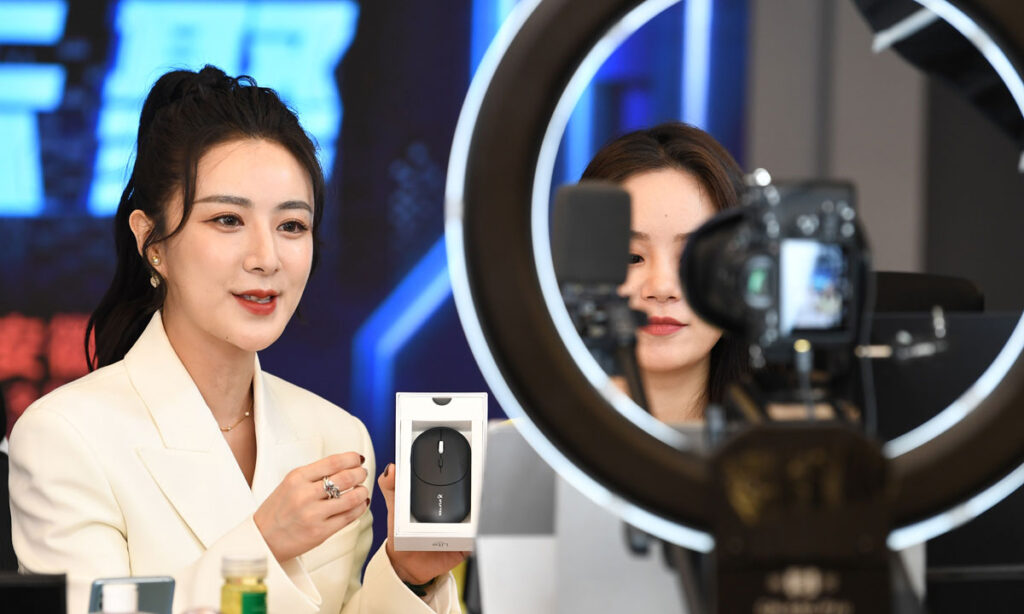
Source: Global Times
Live Shopping in the USA and Europe
However, Live Commerce has not remained confined to China but has begun to spread worldwide, experiencing significant growth wherever it has taken hold. Based on the evolution of the Chinese market, McKinsey and Company predict that globally Live Shopping will represent between 10% and 20% of all eCommerce sales by 2026.
One country where Live Shopping has immediately taken off is the United States. Estimates suggest a Live Commerce market of around $50 billion in 2023 (source: Coresight Research). This value is also rapidly expanding, with a growth of 200% compared to 2 years earlier.
And in Europe? The phenomenon arrived later here but quickly gained consumer acceptance. Already in 2021, according to a Forrester study, 70% of European consumers expressed interest in trying Live Shopping experiences. It is estimated that, in 2024, the number of users participating in live streaming sessions would be 160 million, with 100 million making purchases during the live sessions (source: iResearch).
These data clearly indicate that the market is thriving in Europe as well. This is also evidenced by the emergence and spread of various Live Commerce solutions, as well as the increasing number of brands using them to create live broadcasts on their channels.
What are the Features of Live Shopping shows?
Live broadcasts offer various features that contribute to increasing interactivity and enriching the user shopping experience. Let’s look at the main ones.
Product Highlights
During the live broadcast, it is possible to highlight products, clickable icons of the items that the hosts are presenting at a given time. This allows viewers to click on the icon, view the details, and proceed to view the product page or make a purchase.
Menu
In addition to featured products, there is usually a menu with a catalog of all the items presented during the live session. Similarly, users can click on the products of interest and view the details or proceed to purchase.
Picture-in-picture
Thanks to this feature, the live broadcast on the eCommerce site is reduced to a miniature window. Users can continue to follow the live stream while browsing the site or making purchases.
Chat
Through the chat, users can leave comments and ask questions, such as requesting advice or information about the items, or simply sharing feedback on the live broadcast. Hosts can respond to these questions in real-time, providing advice and dispelling any doubts that may hinder purchases.
Polls
Live streams can also include polls, allowing hosts to ask questions or create mini quizzes for viewers. This stimulates engagement and audience involvement.
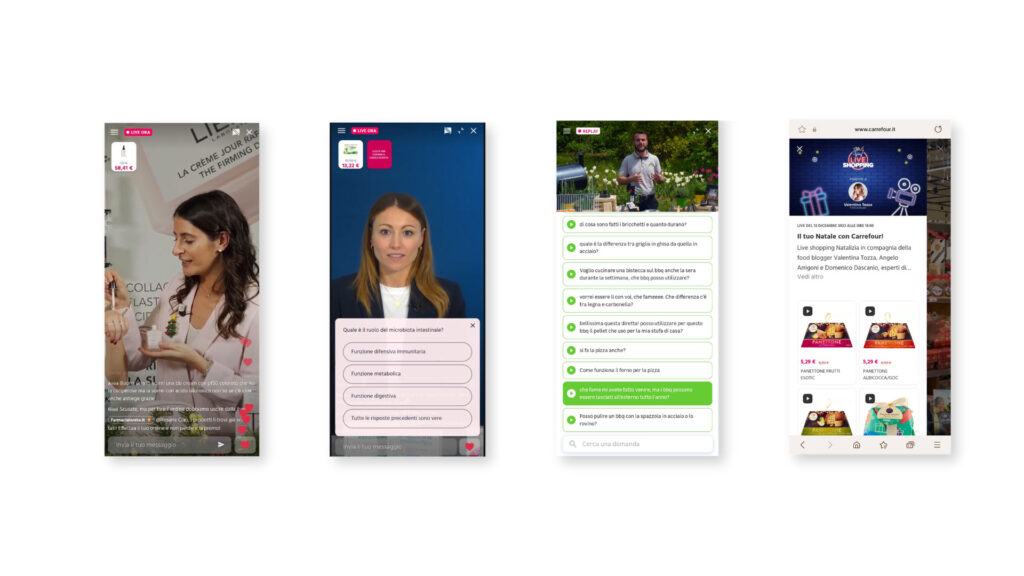
Website or Social Media?
Live broadcasts can be streamed on various platforms, such as proprietary websites, marketplaces, or even social media channels.
However, the current trend in Europe shows a growing interest in streaming live sessions directly on websites. This is because websites offer more integrated and immersive experiences. Thanks to direct integration with the shop, websites allow users to access detailed information, explore products, and complete purchases with fewer clicks than on social media, all without missing a single moment of the live broadcast (with picture-in-picture).
Although social media platforms are excellent channels for gaining wide visibility and high levels of engagement, they do not currently offer seamless and integrated purchasing processes with eCommerce, at least not in Europe. To purchase products, users often have to leave the live broadcast and follow external links to websites.
Furthermore, with the gradual deactivation of third-party cookies on Chrome, it becomes increasingly important to focus on proprietary channels such as websites to collect first-party data. This will only accelerate the trend of brands hosting live streams directly on their sites.
What are the Benefits of Live Commerce?
Live Shopping creates a channel for direct conversation and communication between brands and consumers. Through live broadcasts, companies can recreate the relational and advisory experience typical of in-store shopping.
The main advantage of Live Shopping, in this sense, is that it opens a human dimension in eCommerce.
Consumers are increasingly less fond of the impersonal shopping experiences of traditional eCommerce, where they only have static product pages with images and descriptions at their disposal. Consumers are rather looking for personal interactions – someone to guide them through the purchasing process as a salesperson would in-store. This is exactly what live broadcasts offer.
However, Live Shopping events are not just a form of purchase assistance; they are also entertainment content, similar to small shows capable of engaging and keeping users hooked. The term “Shoppertainment” has emerged to describe this fusion of shopping experiences with entertainment.
All of this results in increased community engagement, leading to higher conversions, engagement, and loyalty.
What Types of Live Broadcasts Can You Create?
There is not just one way to go live; on the contrary, the Live Commerce universe offers a wide range of live models to adopt. The key to success is to experiment, coming up with original formats and creating little shows.
You can organize live broadcasts in-store. For example, you can go live from a boutique, a pharmacy, and even the aisles of a supermarket. This live mode is useful for recreating the offline shopping experience, offering events that combine physical and online stores in an omnichannel manner.
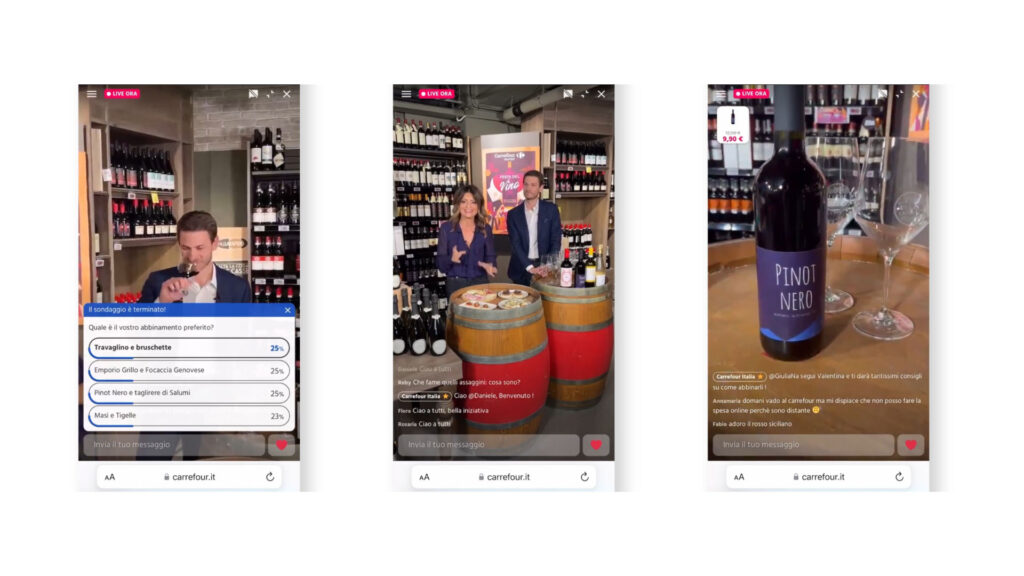
In addition to in-store locations, you can also organize live streams from physical events such as fairs or fashion shows. You can create live tutorials focused on product demonstrations or adopt TV formats such as cooking shows.
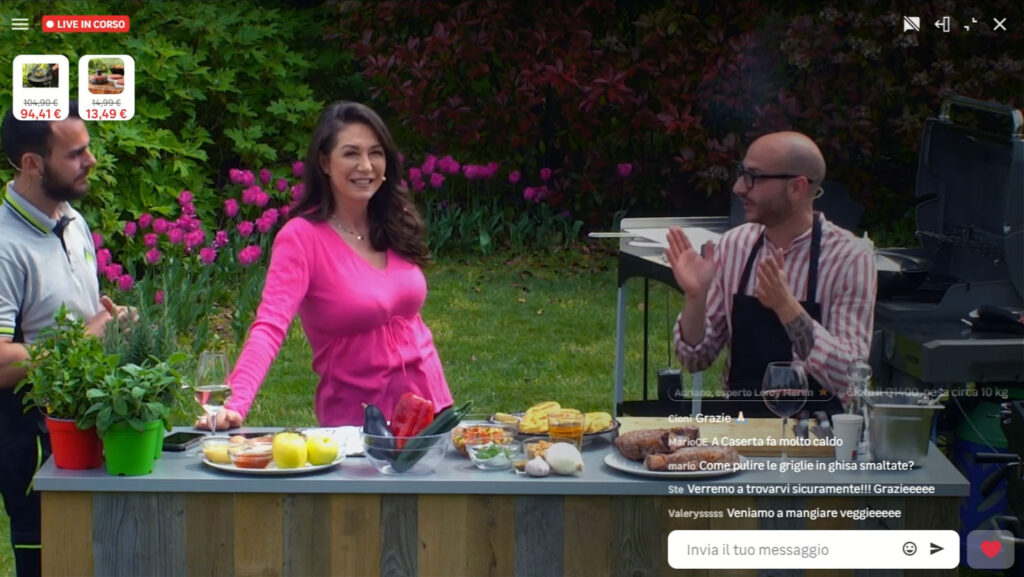
There are many other Live Shopping formats, and it’s up to you to choose the one that best suits your company’s goals and target audience.
Who are the Hosts of Live Streams?
Live broadcasts can be hosted by a variety of figures depending on the type of show proposed.
Often, especially in larger events, they are hosted by television presenters or well-known personalities. However, hosts can also be sales representatives, professionals who know the shop’s products well and can present them during demonstrations or tutorials, guiding viewers through the purchasing process as they would in-store. The involvement of internal company figures, who also serve as brand ambassadors, helps to provide a more authentic representation of the company itself.
Main hosts can then be accompanied by external professionals, influencers, creators, radio speakers, or celebrities. These figures, often invited as co-hosts, contribute to attracting a wider audience, increasing traffic and interest in the live broadcast.
What Do You Need to Build an Effective Live Shopping Strategy?
The effectiveness of Live Shopping is based primarily on strategy. Defining a good strategy is essential for designing and organizing live shows that reach a wide audience, increasing engagement and conversions.
First and foremost, it is important to define the objectives and structure a medium-to-long-term strategic plan. This involves scheduling and planning various live broadcasts regularly. This allows you to build a recurring and loyal audience, as well as explore and test different types of shows.
Then you need to identify the right formats, as well as the hosts, guests, content, products, and offers to present.
An aspect not to be overlooked is the communication plan. In order to attract a large number of viewers and populate your live sessions, you need to promote events on the right channels and in the right ways, adopting an omnichannel approach.
And what about after the live broadcast? Live Shopping events don’t end with the broadcast but continue to generate views and conversions even afterward, thanks to replays. It is in the post-live phase that you have the highest number of views and sales. Therefore, it’s essential to continue promoting events even after the live broadcast – for example, by leveraging snippets of live broadcasts as shoppable videos, i.e., interactive short videos integrated on the website.
Case Studies and Examples
In Italy, many brands have started embracing Live Commerce, creating live broadcasts frequently and regularly and achieving excellent results.
For example, Farmacia Loreto launched its project in November 2022. On “Loreto TV,” various live broadcasts are aired every month by the pharmacists of the stores. Together with experts from partner brands, brand ambassadors, and influencers, the hosts present products, give advice, and address questions or doubts from viewers. The first live broadcast reached 30,000 users in 24 hours and recorded 1 order every 4 seconds in the first 20 minutes alone.
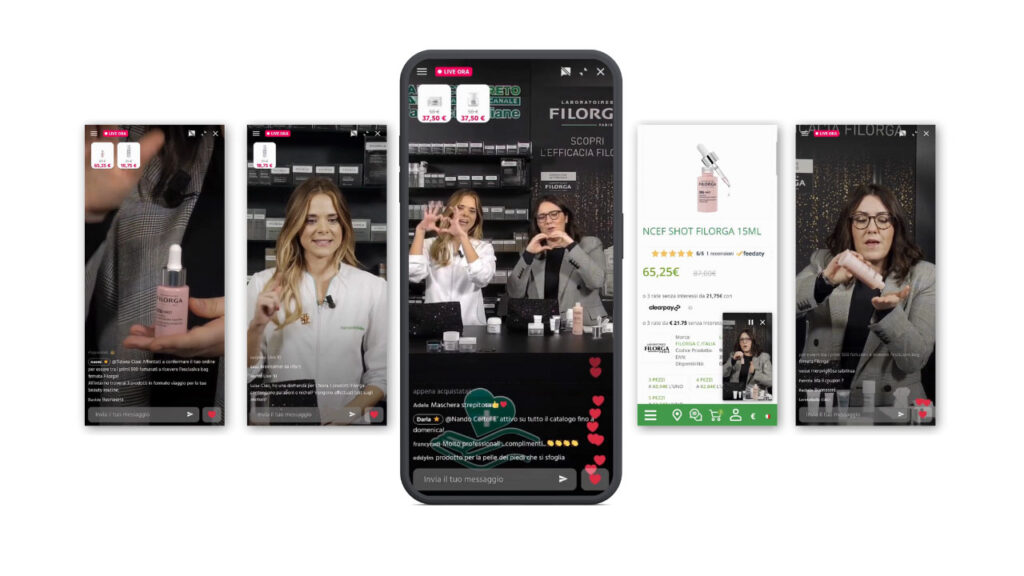
In the fashion industry, a brand that has stood out in the use of Live Shopping is Doppelgänger. The clothing brand launched its Live & Video Commerce project in April 2023, with the aim of enhancing the customer journey in an omnichannel perspective. The first live broadcast, aired in May 2023, reached 68,000 users in less than a week and generated €50,000 in revenue in just 4 days.
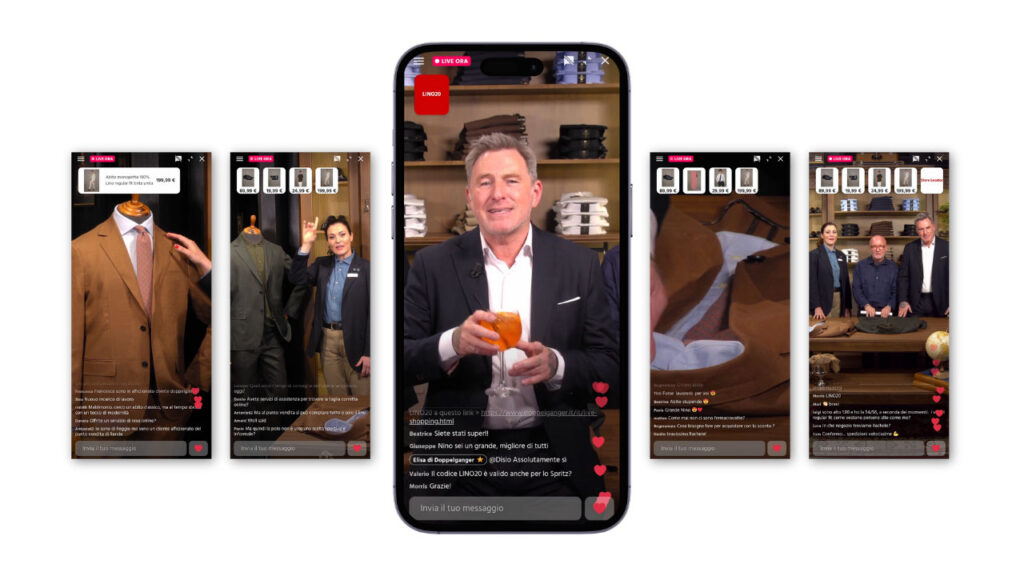
Another company that has achieved remarkable results is Leroy Merlin. Since April 2022, the leading home improvement company has organized various events on topics ranging from barbecue to home and garden furnishings, involving prominent personalities such as Tessa Gelisio, Andrea & Michele from Radio Deejay, and chef Max Mariola. The Christmas live broadcast, aired in November 2023, reached 130,000 users and quadrupled conversions compared to the previous broadcast.
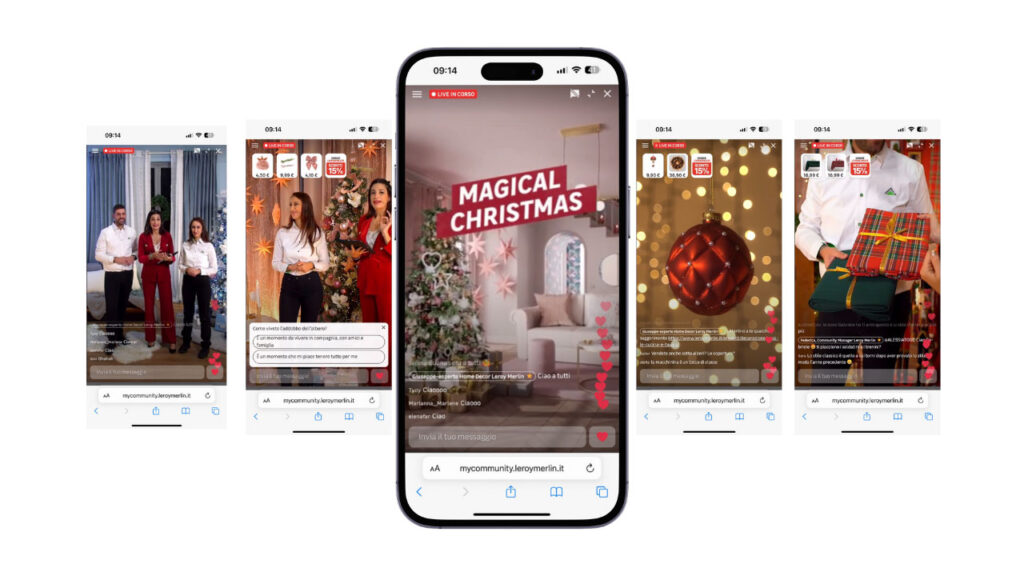
Conclusion
Live Shopping is a powerful sales and connection lever with your audience. It is an effective tool capable of increasing engagement, stimulating conversions, and building communities of users loyal to your brand.
However, the success of this channel is closely linked to the development of a well-thought-out strategy.
If you want to delve into how to activate Live Shopping on your eCommerce site and fully exploit its potential, schedule a call with us. It will be an opportunity to discuss and plan together a personalized Live Commerce strategy.
LET’S TAKE IT LIVE TOGETHER!
